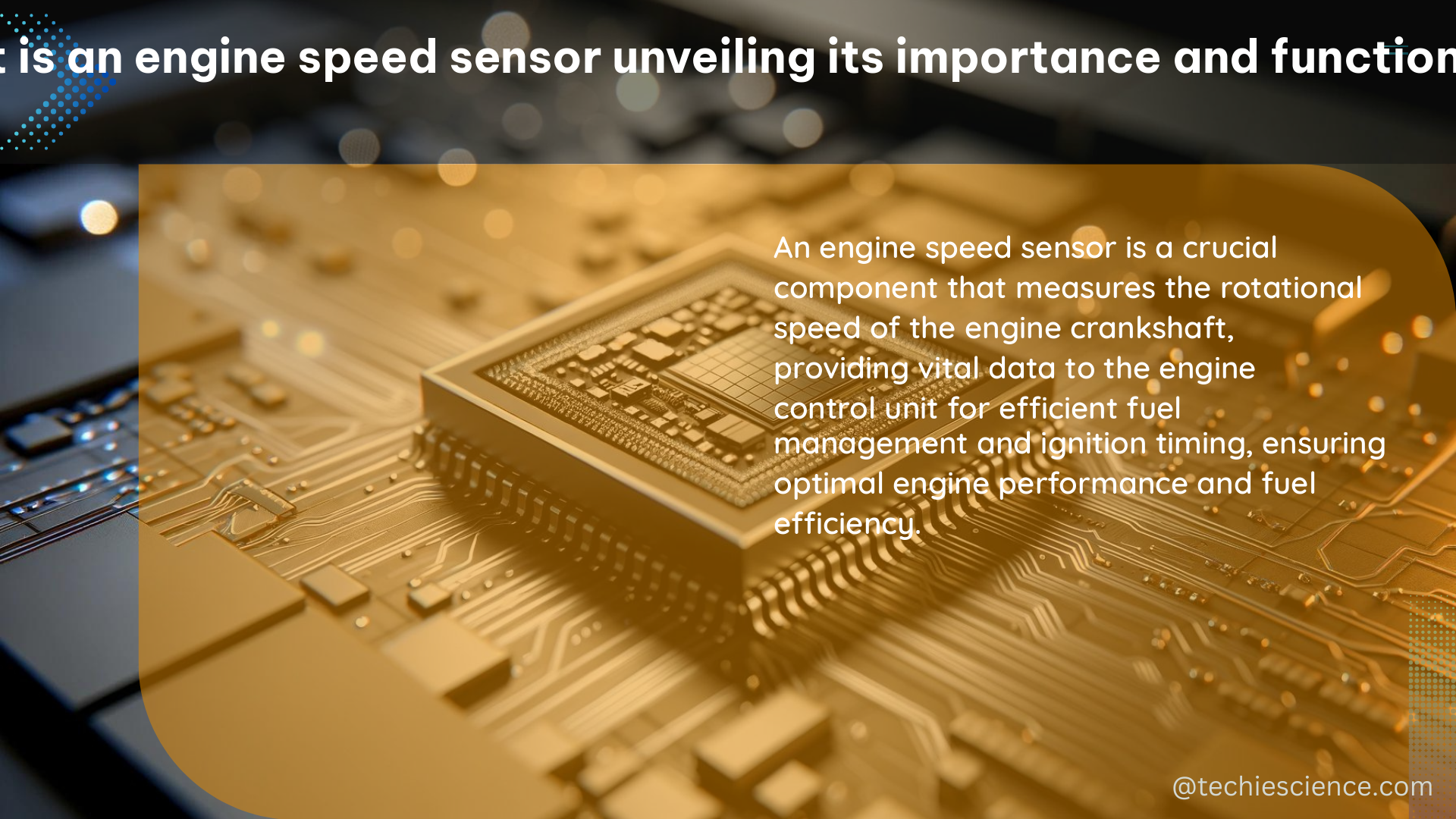An engine speed sensor, also known as a crankshaft position sensor, is a crucial component in a vehicle’s engine management system. It measures the rotation speed and position of the crankshaft, providing essential information to the engine control unit (ECU) for controlling various engine functions. By monitoring the speed of the engine, the sensor allows the ECU to make precise adjustments in parameters like fuel injection, ignition timing, and more, ensuring optimal engine performance, fuel efficiency, and emission management.
Understanding the Operating Principle of Engine Speed Sensors
Engine speed sensors use various technologies to detect the rotation speed and position of the crankshaft. The most common types include:
-
Inductive Sensors: These sensors detect changes in the magnetic field caused by the teeth or notches on a toothed wheel or reluctor ring attached to the crankshaft. As the crankshaft rotates, the teeth or notches pass by the sensor, inducing a fluctuating voltage signal that the ECU can interpret to determine the engine speed and position.
-
Hall Effect Sensors: These sensors use a Hall effect integrated circuit to detect changes in the magnetic field caused by the teeth or notches on a toothed wheel or reluctor ring. The Hall effect sensor generates a digital signal that the ECU can use to calculate engine speed and position.
-
Magnetoresistive Sensors: These sensors use a magnetoresistive element that changes resistance in response to changes in the magnetic field caused by the teeth or notches on a toothed wheel or reluctor ring. The ECU can then interpret the resistance changes to determine engine speed and position.
Regardless of the specific technology used, engine speed sensors are typically located near the crankshaft or the flywheel, enabling precise measurement and determination of the speed and position of the crankshaft.
Importance of the Engine Speed Sensor

The engine speed sensor plays a critical role in the operation of a vehicle’s engine management system. Without it, the ECU would lack a measurement of RPM (Revolutions Per Minute), leading to several performance-related issues:
-
Inefficient Fuel Combustion: The ECU relies on the engine speed sensor to precisely time the fuel injection and ignition events. Without this information, the engine would not be able to achieve optimal fuel-air mixture and combustion, resulting in reduced fuel efficiency and increased emissions.
-
Misfires and Performance Issues: Incorrect timing of fuel injection and ignition due to a malfunctioning engine speed sensor can cause misfires, rough idling, and other performance-related problems.
-
Transmission Shifting Errors: Many modern vehicles use the engine speed sensor data to control the transmission’s shifting patterns. If the sensor is not functioning correctly, the transmission may not shift at the appropriate times, leading to poor drivability and reduced fuel efficiency.
-
Speedometer and Odometer Inaccuracies: The engine speed sensor data is also used to calculate the vehicle’s speed and distance traveled, which are displayed on the speedometer and odometer, respectively. If the sensor is faulty, these readings will be inaccurate.
Quantifiable Data Points for Engine Speed Sensors
Here are some measurable and quantifiable data points related to engine speed sensors:
| Data Point | Typical Range |
|---|---|
| Operating Voltage | 5-12 VDC |
| Output Signal | Analog (sinusoidal) or Digital (square wave) |
| Frequency Range | 0.5 Hz to 10 kHz |
| Accuracy | ±1% to ±5% of actual engine speed |
| Resolution | 0.1 to 1 RPM |
| Operating Temperature Range | -40°C to 125°C (-40°F to 257°F) |
| Sensor Mounting Distance | 0.5 mm to 2.5 mm from toothed wheel/reluctor ring |
| Toothed Wheel/Reluctor Ring Teeth Count | 12 to 60 teeth |
These data points highlight the technical specifications and performance characteristics of engine speed sensors, which are crucial for ensuring proper integration and operation within the vehicle’s engine management system.
Conclusion
The engine speed sensor is a critical component in a vehicle’s engine management system, providing essential information to the ECU for controlling various engine functions. By understanding the operating principle, importance, and quantifiable data points of engine speed sensors, you can better appreciate their role in ensuring optimal engine performance, fuel efficiency, and emission management. With this knowledge, you can make informed decisions when it comes to maintaining, diagnosing, and troubleshooting issues related to the engine speed sensor in your vehicle.
References
- Rotational speed sensors – RHEINTACHO: https://www.rheintacho.de/en/basic-knowledge/rotational-speed-sensors/
- What is a Speed Sensor? Symptoms, Types & Replacement: https://www.autonationmobileservice.com/i/blog/speed-sensor/
- Types of Speed Sensors: Advantages and Disadvantages – Bestas: https://www.bestas.com.tr/en/blog/faq/types-of-speed-sensors-advantages-and-disadvantages
- Speed Sensor – an overview | ScienceDirect Topics: https://www.sciencedirect.com/topics/engineering/speed-sensor
- How Does an Engine Speed Sensor Work? – Sethler: https://sethler.com/how-does-an-engine-speed-sensor-work/

The lambdageeks.com Core SME Team is a group of experienced subject matter experts from diverse scientific and technical fields including Physics, Chemistry, Technology,Electronics & Electrical Engineering, Automotive, Mechanical Engineering. Our team collaborates to create high-quality, well-researched articles on a wide range of science and technology topics for the lambdageeks.com website.
All Our Senior SME are having more than 7 Years of experience in the respective fields . They are either Working Industry Professionals or assocaited With different Universities. Refer Our Authors Page to get to know About our Core SMEs.